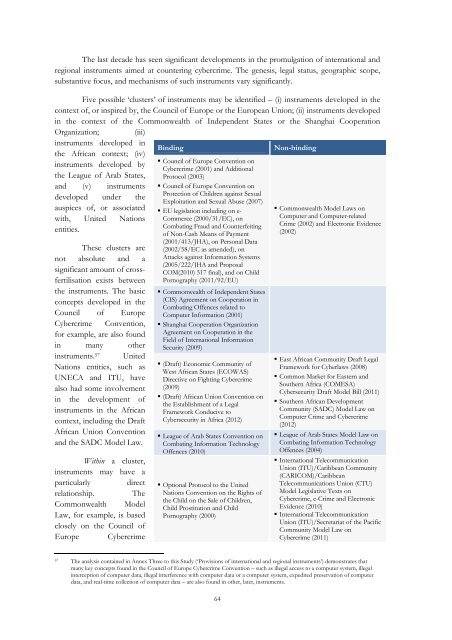COMPREHENSIVE STUDY ON CYBERCRIME - United Nations ...
COMPREHENSIVE STUDY ON CYBERCRIME - United Nations ...
COMPREHENSIVE STUDY ON CYBERCRIME - United Nations ...
You also want an ePaper? Increase the reach of your titles
YUMPU automatically turns print PDFs into web optimized ePapers that Google loves.
The last decade has seen significant developments in the promulgation of international and<br />
regional instruments aimed at countering cybercrime. The genesis, legal status, geographic scope,<br />
substantive focus, and mechanisms of such instruments vary significantly.<br />
Five possible ‘clusters’ of instruments may be identified – (i) instruments developed in the<br />
context of, or inspired by, the Council of Europe or the European Union; (ii) instruments developed<br />
in the context of the Commonwealth of Independent States or the Shanghai Cooperation<br />
Organization; (iii)<br />
instruments developed in<br />
the African context; (iv)<br />
instruments developed by<br />
the League of Arab States,<br />
and (v) instruments<br />
developed under the<br />
auspices of, or associated<br />
with, <strong>United</strong> <strong>Nations</strong><br />
entities.<br />
These clusters are<br />
not absolute and a<br />
significant amount of crossfertilisation<br />
exists between<br />
the instruments. The basic<br />
concepts developed in the<br />
Council of Europe<br />
Cybercrime Convention,<br />
for example, are also found<br />
in many other<br />
instruments. 57 <strong>United</strong><br />
<strong>Nations</strong> entities, such as<br />
UNECA and ITU, have<br />
also had some involvement<br />
in the development of<br />
instruments in the African<br />
context, including the Draft<br />
African Union Convention<br />
and the SADC Model Law.<br />
Within a cluster,<br />
instruments may have a<br />
particularly direct<br />
relationship. The<br />
Commonwealth Model<br />
Law, for example, is based<br />
closely on the Council of<br />
Europe Cybercrime<br />
Binding<br />
• Council of Europe Convention on<br />
Cybercrime (2001) and Additional<br />
Protocol (2003)<br />
• Council of Europe Convention on<br />
Protection of Children against Sexual<br />
Exploitation and Sexual Abuse (2007)<br />
• EU legislation including on e-<br />
Commerce (2000/31/EC), on<br />
Combating Fraud and Counterfeiting<br />
of Non-Cash Means of Payment<br />
(2001/413/JHA), on Personal Data<br />
(2002/58/EC as amended), on<br />
Attacks against Information Systems<br />
(2005/222/JHA and Proposal<br />
COM(2010) 517 final), and on Child<br />
Pornography (2011/92/EU)<br />
• Commonwealth of Independent States<br />
(CIS) Agreement on Cooperation in<br />
Combating Offences related to<br />
Computer Information (2001)<br />
• Shanghai Cooperation Organization<br />
Agreement on Cooperation in the<br />
Field of International Information<br />
Security (2009)<br />
• (Draft) Economic Community of<br />
West African States (ECOWAS)<br />
Directive on Fighting Cybercrime<br />
(2009)<br />
• (Draft) African Union Convention on<br />
the Establishment of a Legal<br />
Framework Conducive to<br />
Cybersecurity in Africa (2012)<br />
• League of Arab States Convention on<br />
Combating Information Technology<br />
Offences (2010)<br />
• Optional Protocol to the <strong>United</strong><br />
<strong>Nations</strong> Convention on the Rights of<br />
the Child on the Sale of Children,<br />
Child Prostitution and Child<br />
Pornography (2000)<br />
Non-binding<br />
• Commonwealth Model Laws on<br />
Computer and Computer-related<br />
Crime (2002) and Electronic Evidence<br />
(2002)<br />
• East African Community Draft Legal<br />
Framework for Cyberlaws (2008)<br />
• Common Market for Eastern and<br />
Southern Africa (COMESA)<br />
Cybersecurity Draft Model Bill (2011)<br />
• Southern African Development<br />
Community (SADC) Model Law on<br />
Computer Crime and Cybercrime<br />
(2012)<br />
• League of Arab States Model Law on<br />
Combating Information Technology<br />
Offences (2004)<br />
• International Telecommunication<br />
Union (ITU)/Caribbean Community<br />
(CARICOM)/Caribbean<br />
Telecommunications Union (CTU)<br />
Model Legislative Texts on<br />
Cybercrime, e-Crime and Electronic<br />
Evidence (2010)<br />
• International Telecommunication<br />
Union (ITU)/Secretariat of the Pacific<br />
Community Model Law on<br />
Cybercrime (2011)<br />
57 The analysis contained in Annex Three to this Study (‘Provisions of international and regional instruments’) demonstrates that<br />
many key concepts found in the Council of Europe Cybercrime Convention – such as illegal access to a computer system, illegal<br />
interception of computer data, illegal interference with computer data or a computer system, expedited preservation of computer<br />
data, and real-time collection of computer data – are also found in other, later, instruments.<br />
64
















